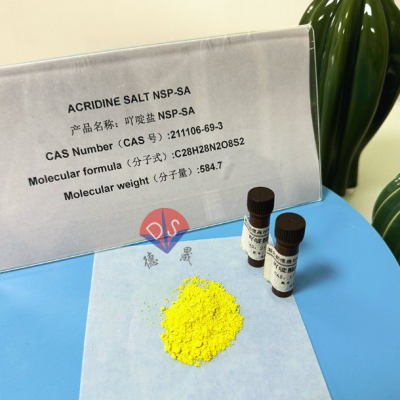Home > Products > Chemiluminescence reagent > Detailed Introduction of Luminescent Reagent NSP-SA 211106-69-3
Detailed Introduction of Luminescent Reagent NSP-SA 211106-69-3
≥10 Milligrams
- Shanghai
- T/T L/C
- 5 days
You May Like
-
Stability And Precautions of Acridine Ester (NSP-SA-NHS)
-
The Labeling Principle And Application of Acridine Hydrazide NSP-SA-ADH
-
Application And pH Stability of Acetyl CoA Oxidase
-
Tris And Glutamate Dehydrogenase Work Together on Homocysteine Assay Kit
-
The Relationship Between Purine Nucleoside Phosphorylase And Nucleic Acid Synthesis And Decomposition
-
Introduction of Desheng on Alpha Glucosidase
Product Details
| CAS No. | 211106-69-3 | Application | Scientific Research | |
| Usage | Laboratory Reagents, Analytical Reagents, Diagnostic Reagents | Property | Biochemical Reagent | |
| Classification | High Purity Material | Grade | AR |
Product Description
Acridine salt NSP-SA belongs to the class of luminescent reagents acridine compounds. As an effective chemiluminescent marker, it has obvious advantages, such as rapid and stable luminescence, high sensitivity and signal-to-noise ratio, and low susceptibility to external interference. At the same time, the requirements for various experimental operations are simple and the accuracy of the obtained results is high, which plays an indispensable role in the automation of immune analysis operations. Below is a specific introduction to it, which can also be used separately from other reagents in the later stage.
1、 Composition and properties
The luminescent reagent NSP-SA, with a CAS of 211106-69-3 and a molecular weight of 584.66, appears as a yellow powder with high solubility and stability in water. Its diluted solution shows purple or green fluorescence. If further diluted, it will become free acridine due to salt hydrolysis, exhibiting purple fluorescence. Acridine salt NSP-SA has a wide range of applications and can be used as a photocatalyst, dye preparation, etc.
2、 Purpose:
The luminescent reagent acridine salt NSP-SA can be used in biomedical research, such as detecting protein, nucleic acid, antigen antibody and other markers. By observing the fluorescence signal in the sample through acridine salt, the presence of target molecules in the sample can be determined. In addition, NSP-SA can also be used in fields such as photocatalyst and dye preparation.
3、 Usage method
The use of acridine salt NSP-SA is relatively simple. Firstly, the reagent needs to be mixed with a fluorescent dye to form a fluorescent labeling complex. Then, the complex is added to the sample to be tested, such as a protein or nucleic acid solution. Finally, the fluorescence signal in the sample can be observed using a fluorescence microscope. Pay attention to avoiding reagent contamination and light intensity issues during use.
4、 Precautions
When using acridine salt NSP-SA, the following points should be noted:
1. Reagents should be stored in a cool and dry place, avoiding direct sunlight and high temperatures, which may cause changes in performance.
2. Before use, it is necessary to check the purity and expiration date of the reagents. Expired reagents can affect the test results. Once a pungent odor is produced, use should be stopped immediately.
3. During the operation, attention should be paid to avoiding reagent contamination and external cross infection.
As an advantageous supplier of luminescent reagents, Desheng produces six types of acridine series products for customers to choose from comprehensively. At the same time, its purity can reach up to 98%, and its luminescence is sensitive and rapid, which is conducive to various experimental research uses. If you have any relevant intentions, please click on the website to contact us!
Contact Us

- Hubei New Desheng Material Technology Co., Ltd
- Contact nameDoris Yang Chat Now
Product Categories
| Additive for blood collection | Biological buffer | Chemiluminescence reagent | Chromogenic substrate |
| enzyme preparation |
New Products
-
Glucose Dehydrogenase: a Key Enzyme in IVD in Vitro Diagnostic Reagents
-
Detailed Explanation of Storage Methods for Adenosine Deaminase (ADA)
-
Biological Functions And Applications of Malate Dehydrogenase
-
The Price of TRIS-HCL 1185-53-1 Produced by Desheng Has Been Lowered. Please Feel Free to Consult And Purchase
-
Why Should we Pay Attention to Solubility When Purchasing Biological Buffer TRIS 77-86-1?
-
The Effect of Purity of BICINE Powder 150-25-4 as a Biological Buffer on the Performance of Buffer Solutions
-
Introduction to the Transportation Packaging of CAPS Powder 1135-40-6, a Biological Buffering Agent
-
Compatibility of Biological Buffer MOPS 1132-61-2 With Other Reagents
-
Application of Biological Buffer TAPS 29915-38-6 in Enzyme Activity Research
-
The Advantage of High Purity of EPPS Powder 16052-06-5 Raw Materials for Biological Buffering Agents
-
Advantages of MOPSO Buffer 68399-77-9 in Low-temperature Biochemical Work
-
What Does HEPES Buffer 7365-45-9 do for Cell Culture
-
Application of Biological Buffer PIPES 5625-37-6 in Biochemical Research
-
How to Determine And Choose a BES Buffer 10191-18-1 Manufacturer for Procurement
-
Biological Buffer DIPSO (68399-80-4) Detailed Description for Quick Understanding
-
Multiple Applications of CHES Buffer in Biological Research
-
Detailed Functions And Uses of Serum Separation Gel
-
Sodium Heparin, a Specialized Additive for Blood Glucose Test Tubes
-
How to Detect Electrolytes With Lithium Heparin
-
Precautions for Using Anticoagulant EDTA Dipotassium
-
Manufacturer of Blood Collection Tube Additive EDTA Tripotassium
-
Spot Supply of Blood Coagulants
-
How to Choose High-efficiency Coagulant Powder And Coagulant Suspension?
-
Factors Affecting the Silicification Effect of Water-soluble Silicification Agents on Blood Collection Tubes
Popular Searches
Recommended Products
- Sodium Metasilicate Granular 25kg Factory
- Sodium Molybdate Export-HOOCHEMTEC
- PAPP Sodium Metasilicate Pentahydrate Factory Price Cas 66034-17-1
- Sodium Metasilicate Granular in Detergent Industrial
- STPP Sodium Metasilicate Granular in Detergent Industrial SMS-5H2O
- Cocamido Propyl Betaine 35% Stability Factory Price
- Potato Dextrose Agar
- MacC /MacConkey Agar
- EMB Agar
- Tryptose
- Lecithin From Egg Yolk CAS:93685-90-6
- HSPC CAS:92128-87-5
Find Similar Products By Category
- Chemicals > Chemical Reagent
- Please Enter your Email Address
- Please enter the content for your inquiry.
We will find the most reliable suppliers for you according to your description.
Send Now-
 Doris Yang
Hi there! Welcome to my shop. Let me know if you have any questions.
Doris Yang
Hi there! Welcome to my shop. Let me know if you have any questions.
Your message has exceeded the limit.

- Contact supplier for lowest price
- Customized Request
- Request Sample
- Request Free Catalogs
Your message has exceeded the limit.
-
Purchase Quantity
-
*Sourcing Details
Your inquiry content must be between 10 to 5000 characters.
-
*Email
Please enter Your valid email address.
-
Mobile





